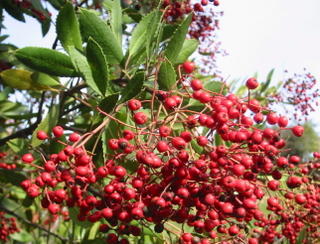November Los Feliz Ledger Column - "Particulars of a Plant Palette"

(photo of Toyon berries at right taken by blogger)
Drum roll please! Plants for our backyard makeover have been selected at long last—after three months of planning and construction. The palette we’ve chosen will please birds, bees, butterflies and me while working well with our garden’s conditions: eastern exposure with three mature trees, relatively well-draining soil and some sloping areas. All plants are native to California and survive with minimal water in the dry months once established, after about one to three years of regular watering.
One of the helpful rules of landscape design is to start with larger plants and work down from there. Since we already have enough trees, I moved directly to evergreen shrubs that will form the backbone of our garden’s greenery.
First up is Toyon (Heteromeles arbutifolia), beloved for gorgeous red berries that bejewel its branches right around Christmastime and provide food for birds. Flowers that precede the holiday display are a joy for pollinators. Toyon, which grows up to 24 feet tall, can also be used as a hedge or a small tree, by trimming the lower branches as it matures.
Malva Rosa (Lavatera assurgentifolia) is the sensible California substitute for whitefly-infested, non-native Hibiscus—
exactly what it is replacing in our garden. It reaches about 6 to 10 feet high and 3 to 12 feet wide, has 3-inch striped purplish pink flowers almost year-round and granny-smith-green, maple-shaped leaves.
California Wild Lilac (Ceanothus) comes in many forms and will suit an array of our garden’s needs. The ‘Ray Hartman’ cultivar grows to about 20 feet tall and wide. It has dainty, clustered spires of fragrant, blue flowers. Deer devour Ceanothus, so steer clear of it if Bambi is a frequent visitor.
On the opposite end of the spectrum in the Ceanothus genus is ‘Carmel Creeper’ (C. griseus horizontalis). A ground cover with 2-inch glossy green leaves, it is excellent for slope stabilization and a stellar stand-in for invasive ivy. Flowers are powder blue.
Coffeeberry, (Rhamnus californica), no relation to your morning java, is a delicate shrub that offers birds dark, shiny, perfectly round fruit. Leaves are narrow, matte green and slightly wispy. I’ve chosen the ‘Bonita Linda’ cultivar. It matures at about 8 feet tall and 10 feet wide.
Rounding out the shrub shortlist is Bush Anemone (Carpenteria californica). It is a slow grower that reaches 4 to 6 feet tall and wide. I covet its waxy, pointed green leaves and large clusters of white, fragrant flowers with bright yellow centers. The ‘Elizabeth’ cultivar is great for a cutting garden—bring the blooms inside.
Up next are perennials and grasses. They’re shorter than shrubs and fill in spaces between them and the trees.
Pitcher Sage (Lepechinia fragrans) is deliciously aromatic and flowers draw in nectar-seeking friends. Blue-eyed Grass (Sisyrinchium bellum) looks just as it sounds—and is even cuter than you can imagine. Western Columbine (Aquilegia formosa) produces rich, red, arachnid-looking flowers in spring that—after setting seed—offer a valuable food source for several different species of birds. Island Alum Root (Heuchera maxima) comes in many different colors and sizes. The long, tall, strappy leaves of Giant Wild Rye (Leymus condensatus) and its relative, ‘Canyon Prince,’ will lend shape and color variation (gray-green and blue) to our garden. Douglas Iris (Iris douglasiana) and its cultivars bring back memories of East Coast style Irises that I grew up with, but are even better in my view.
Finally, we arrive at the slope savers and terrace wall decorators—groundcovers. I’ve already mentioned my favorite, ‘Carmel Creeper.’ It will be accompanied by these beauties: California Strawberry (Fragaria vesca) with pretty white flowers and small, red, edible fruit; Evergreen Currant/Catalina Perfume (Ribes viburnifolium); California Fuchsia (Zauschneria californica), technically not a groundcover but low-growing enough to do the trick; and Coyote Mint (Mondardella villosa), also a little taller, makes the cut for a divine minty fragrance and flowers frequented by butterflies.
More plants will be added over time as I discover what works best. Building a dream garden is an ever-evolving process and that’s the magic of it. This palette is a great place to start. I’ll take it with me as I shop the plentiful plant sales of the season, including Rancho Santa Ana Botanic Garden’s on Nov. 5th and 6th (rsabg.org) and the one I am organizing at Eaton Canyon Nature Center in Pasadena on Nov. 19th from 9 a.m. until 2 p.m. (cnps-sgm.org). I hope to see you there!

1 Comments:
nice, cozy place you got here :)..
By Anonymous, at 11:06 PM
Anonymous, at 11:06 PM
Post a Comment
<< Home